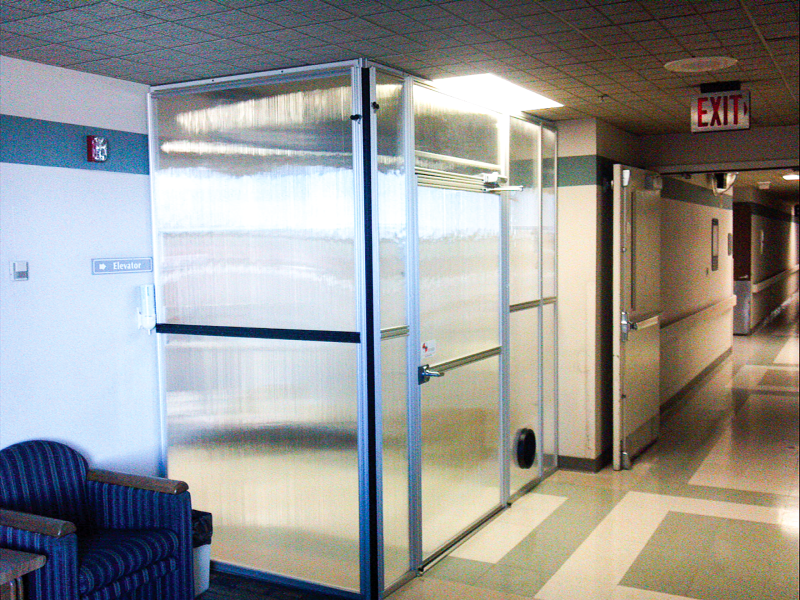The Versatility of Extruded Aluminum Framing Systems
When the objective is to meet production goals, manufacturers seek solutions that are cost effective, efficient and flexible, so it’s not surprising that extruded aluminum framing systems, which provide all these benefits and then some, are more often being considered over traditional steel alternatives in a multitude of industrial, automation and manufacturing applications.
What are Aluminum Extruded Framing Systems?

Let’s start with the basics. Extruded materials are those that are pushed or pulled through a cast or die of a specific pattern to create a uniform profile. So, in this case, the material is aluminum, which is strong, robust and, when anodized resists corrosion. Further, because extruded aluminum can be made with “t-slot” profiles, the pieces can be interlocked and secured in place with fasteners, nuts or bolts, versus using welds, to create strong and sturdy frames, making extruded aluminum a great material for building industrial framing systems.
4 Benefits of Extruded Aluminum Framing Systems
Extruded aluminum framing systems offer a range of benefits for manufacturers looking to reduce costs, increase efficiency and embrace flexibility. Here are four of the most valuable advantages of extruded aluminum framing systems:
| Efficient Assembly | One of the greatest advantages when using extruded aluminum framing systems is how quickly and efficiently they can be erected and customized. Since no welding, priming, painting or coating is required (as needed when using steel structures), installation is very efficient and is often done using simple tools and fasteners, making extruded aluminum framing systems faster to erect, as well as less costly. |
| Versatility | Extruded aluminum framing is also lightweight, simple to measure, square and adjust and is available in a range of sizes. For these reasons, extruded aluminum framing systems are fully customizable and are easy to reconfigure if there is need to change the arrangement due to fluctuating worksite or equipment needs, making them a very flexible solution for manufacturers who may be faced with frequent changes in production. This versatility also gives extruded aluminum framing more value over their lifetime. |
| High Strength | Despite being simple to install and inherently flexible, extruded aluminum framing systems are also surprisingly strong, sturdy and robust. As a matter of fact, experts suggest that extruded aluminum is as strong as steel but is more cost effective because it does not require welding, priming or painting, resulting in a more cost- and time-effective solution for industrial framing needs. |
| Corrosion Resistant | Further, because extruded aluminum is corrosion resistant, it is more likely to last longer in wet or corrosive industrial environments without the hassle of re-coating or re-painting after years in service as is common with steel framing which is prone to rust. Further, many providers of extruded aluminum framing systems offer smooth-surface versions, making them ideal for cleanroom environments, such as those found in electronics or medical manufacturing. |
Applications for Extruded Aluminum Framing Systems
Because extruded aluminum framing systems are cost effective, strong, flexible and corrosion resistant, they can be applied just about anywhere in an industrial facility. Common applications include:
- Machine frames and bases
- Workstations
- Assembly lines
- Frames for material handling/conveyor systems
- Inspection stations
- Platforms for robots
- Automation workcells
- Cleanroom frames, bases or workcells
- Structural framing
- Machine guarding
- Enclosures
- Safety fencing
Extruded Aluminum Framing Systems may be the Superior Choice
While both steel and extruded aluminum frames can be used in any of the applications mentioned above, there are certain instances where extruded aluminum framing systems are clearly the smartest choice. In addition to providing a lower overall cost, flexible and strong framing system, extruded aluminum framing systems are superior when…
- Weight is a factor: Often steel frames add a significant amount of weight to a project, so in situations where a project has a weight limit, extruded aluminum framing will provide a viable alternative as it will provide the same performance characteristics as steel, but at a significantly lower weight.
- Modifications are expected: Once welds are in place, steel structures are permanent and modifications can only be made by cutting off at the assembly, reconfiguring, re-welding, re-priming and re-painting, which is labor intensive and costly. However, extruded aluminum framing is easy to disassemble and reassemble into new configurations. It is lightweight and easy to move. System components are generally interchangeable if different lengths are needed for a new application. So, in situations where products or processes are apt to change or in facilities where there are frequent setups and teardowns, extruded aluminum framing systems will provide the flexibility to do so, quickly and with little or no cost.
- Corrosion is an issue: If the framing system will be in a location that is subject to corrosion or rust, extruded aluminum framing systems are the way to go as anodized aluminum resists corrosion while steel framing needs a lot of labor to prepare it for use in wet environments.
While extruded aluminum framing systems may be a lesser-known framing option than traditional steel, they offer the similar strength, but at a lower cost, have fewer labor and maintenance requirements and provide greater flexibility, as well as corrosion resistance. Check in with a representative at JHFOSTER to see why extruded aluminum framing systems are a great choice for framing needs in manufacturing and industrial facilities that are trying to become more cost effective, while remaining productive and agile.
